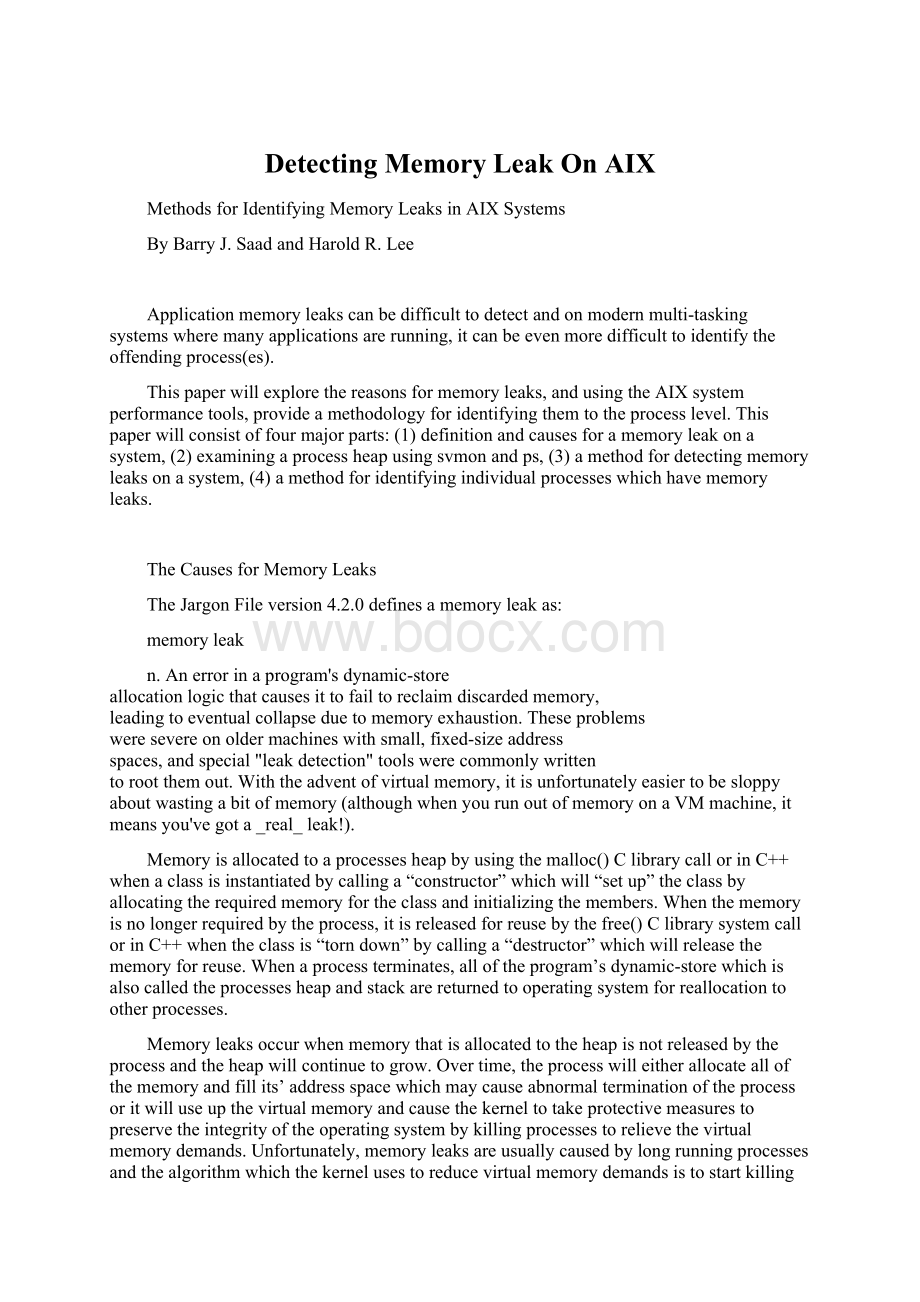Detecting Memory Leak OnAIX.docx
《Detecting Memory Leak OnAIX.docx》由会员分享,可在线阅读,更多相关《Detecting Memory Leak OnAIX.docx(12页珍藏版)》请在冰豆网上搜索。

DetectingMemoryLeakOnAIX
MethodsforIdentifyingMemoryLeaksinAIXSystems
ByBarryJ.SaadandHaroldR.Lee
Applicationmemoryleakscanbedifficulttodetectandonmodernmulti-taskingsystemswheremanyapplicationsarerunning,itcanbeevenmoredifficulttoidentifytheoffendingprocess(es).
Thispaperwillexplorethereasonsformemoryleaks,andusingtheAIXsystemperformancetools,provideamethodologyforidentifyingthemtotheprocesslevel.Thispaperwillconsistoffourmajorparts:
(1)definitionandcausesforamemoryleakonasystem,
(2)examiningaprocessheapusingsvmonandps,(3)amethodfordetectingmemoryleaksonasystem,(4)amethodforidentifyingindividualprocesseswhichhavememoryleaks.
TheCausesforMemoryLeaks
TheJargonFileversion4.2.0definesamemoryleakas:
memoryleak
n.Anerrorinaprogram'sdynamic-store
allocationlogicthatcausesittofailtoreclaimdiscardedmemory,
leadingtoeventualcollapseduetomemoryexhaustion.Theseproblems
weresevereonoldermachineswithsmall,fixed-sizeaddress
spaces,andspecial"leakdetection"toolswerecommonlywritten
torootthemout.Withtheadventofvirtualmemory,itisunfortunatelyeasiertobesloppyaboutwastingabitofmemory(althoughwhenyourunoutofmemoryonaVMmachine,itmeansyou'vegota_real_leak!
).
Memoryisallocatedtoaprocessesheapbyusingthemalloc()ClibrarycallorinC++whenaclassisinstantiatedbycallinga“constructor”whichwill“setup”theclassbyallocatingtherequiredmemoryfortheclassandinitializingthemembers.Whenthememoryisnolongerrequiredbytheprocess,itisreleasedforreusebythefree()ClibrarysystemcallorinC++whentheclassis“torndown”bycallinga“destructor”whichwillreleasethememoryforreuse.Whenaprocessterminates,alloftheprogram’sdynamic-storewhichisalsocalledtheprocessesheapandstackarereturnedtooperatingsystemforreallocationtootherprocesses.
Memoryleaksoccurwhenmemorythatisallocatedtotheheapisnotreleasedbytheprocessandtheheapwillcontinuetogrow.Overtime,theprocesswilleitherallocateallofthememoryandfillits’addressspacewhichmaycauseabnormalterminationoftheprocessoritwilluseupthevirtualmemoryandcausethekerneltotakeprotectivemeasurestopreservetheintegrityoftheoperatingsystembykillingprocessestorelievethevirtualmemorydemands.Unfortunately,memoryleaksareusuallycausedbylongrunningprocessesandthealgorithmwhichthekernelusestoreducevirtualmemorydemandsistostartkillingprocessesbasedonthe“youngest”process(mostrecentlycreated)andworkingtowardthe“oldest”.Thiscanhavetheeffectofmanyprocessesbeing“killed”beforetheoffendingprocessisdealtwith.
Duetothecomplexityofprogramsandthelevelsofmemoryallocationanddeallocationabstractioninobjectorientedprograms,memoryleaksaresometimesverydifficultifnotimpossibletocompletelyeliminate.Oneapproachtothisproblemistolimitthelifespanofaprogramwheretheprogramisterminatedbeforeanypotentialmemoryleaksareallowedtogrowenoughtobecomeaproblem.TheApachewebserverisanexampleofthisapproach.WhentheApacheserverisstarted,aparentprocessstartedwhichallocatesverylittlememoryanddoesverylittlework.Theparent’sjobistoinitiallyspawnsomenumberofchildserverprocesssetbytheStartServersdirectiveintheconfigurationfile,andthentotrytomaintainthenumberofchildserverprocessbetweentwolevelseitherbycreatingorkillingadditionalprocesses.ThiswindowissetbytheMaxSpareServersandMinSpareServersdirectivesinthestartupconfigurationfile.
MaxRequestsPerChilddirective
TheMaxRequestsPerChilddirectivesetsthelimitonthenumberofrequeststhatanindividualchildserverprocesswillhandle.AfterMaxRequestsPerChildrequests,thechildprocesswilldie.IfMaxRequestsPerChildis0,thentheprocesswillneverexpire.
SettingMaxRequestsPerChildtoanon-zerolimithastwobeneficialeffects:
∙itlimitstheamountofmemorythatprocesscanconsumeby(accidental)memoryleakage;
∙bygivingprocessesafinitelifetime,ithelpsreducethenumberofprocesseswhentheserverloadreduces.
Eachchildserverprocesseswillkeeptrackofthenumberofrequestswhichitwillhandleandafterthisnumberhasbeenreached,theprocesswilldieandreturnallofthevirtualmemorytothekernelheapforreallocation.Thefollowingsnippetisfromtheconfigurationfileinstructionpage.Noticethereasongivenforlimitingthelifetimeofthechild:
NotallapplicationshavetheflexibilityofApachetodealwithpotentialleaks.Anotherstrategyisforcompaniestoscheduleregularintervalsfortheapplicationstoberecycled.Thisinvolvesshuttingdowntheapplicationsandrestartingthem.Whilesomereboottheentiresystem,thisisnotnecessaryunlesstherearemitigatingcircumstancessuchasamaintenancepatchorarebootspecifictuningchange(e.g.changingtheasynchronoussubsystemparameters).
Anotherformofprocessmemoryleakageiscalled“heapfragmentation”.Heapfragmentation,whichisthebaneofoperatingsystemdesign,issomethingdevelopershavehadtocontendwithsincethebeginning.Agooglesearchon“heapfragmentation”willreturnover64,000hitsillustratingthemagnitudeofthisissue.Heapfragmentationiswhenavailablememoryisbrokenintosmall,non-contiguousblocks.Whenthisoccurs,memoryallocationcanfaileventhoughthereisenoughmemoryintheheaptosatisfytherequest,becausenooneblockofmemoryislargeenoughtosatisfytheallocationrequest.
Forapplicationsthathavealowmemoryusage,thestandardheapisadequate;allocationswillnotfailduetoheapfragmentation.However,iftheapplicationallocatesmemoryfrequentlyandusesavarietyofallocationsizes,memoryallocationcanfailduetoheapfragmentation.
Heapfragmentationiscausedbynumeroussubsequentmalloc()sandfree()sontheprocessheapwithwidelyvaryingsizes.Thiscause“holes”toforminthecontiguousheapandunlessamalloc()issmallenoughtousethespacewithina“hole”theprocessheapmustgrowtosatisfytherequest.
Onestrategyfordealingwithheapfragmentationistoemployatechniquecalled“GarbageCollection”.Whenarequestcannotbesatisfiedfromtheheapduetofragmentation,thegarbagecollectionroutineiscalledwhichmovesallofthe“holes”totheendoftheheap,makingallofthespaceavailableattheendoftheheap.Thisgarbagecollectionisanalogoustodefragmentingaharddrive,whichmovesalloftheunusedspacetotheend.
Someoftheearlyoperatingsystemsemployedgarbagecollectiontechniqueshoweverthiscausesveryerraticperformancefromthesystemsinceallactivityhadtostopwhilethememorywasrearranged.TheJavavirtualmachine(JVM),whichisa“guest”operatingsystem,currentlyusesthismethodwithsimilarresults.Garbagecollectionisnotusedonmostoperatingsystemstodaydueinparttotheerraticperformanceitproduces.
Anotherstrategywhichsomeprogramsusetoeliminatethisistomanagetheheapinternallythroughtheuseofpointers.Whentheprogramstartsthereisasinglememoryallocationcalltoobtaintheheapandthentheprogramitselfwillallocateportionsoutofittosatisfytheinternalrequests.MostdatabaseprogramslikeOracleandDB2usethismethodofinternalmemorymanagement.
Operatingsystemdeveloperscontinuetoworkonmoreefficientmemoryallocationalgorithmsandincorporatethemintothekernelstoreducethisissuetooneonminimumimpact.TheWindows™developershaveintroducedaheapmanagercalledthe“LowFragmentationHeap”(LFH)whichplacestheholesinaCartesianbtreestructuresimilartotheAIX4.2–5.2mallocroutineknownasthe“Yorktownmalloc”sinceitwasdevelopedbytheYorktownresearchfacility.
Anewmalloccalledthe“watsonmalloc”isavailableonAIX5.3.TheWatsonmallocwhichiscachebasedandusesasimplifiedrbtree(red-blacktree)structureincreasesmallocperformanceaswellasreducingheapfragmentation.Thenewmalloc()isoptimizedforlargemulti-threadedapplicationsandtimewilltellhowmuchmoreefficientitis.Formoreinformationonthismallocrefertothefollowinglink:
Refertothesection-UnderstandingtheWatsonAllocationPolicy
Fromasystemadministrationperspective,heapfragmentationisdealtwiththesamemannerasamemoryleak.Theapplicationsmustbequiescedandrestarted.
ExaminingAProcessHeapUsingsvmonandps
Foranoverviewofthevirtualmemorymanagementataprocesslevel,refertothefollowingarticlesandinfopages:
http:
//w3-
Article–UnderstandingVirtualMemoryManagement
Alsorefertothemanorinfopageonthesvmonandpscommands
Theprocessesvirtualmemoryfootprintconsistsofthreeseparateitems.Theactual
(1)heapandthe
(2)processstackwhichisaddressedby(esid)register“2”,andthe(3)sharedlibrarydatawhichisaddressedbyregister“f”.Theloadersegment“d”issharedbyallprocessesandisignored.
#svmon-nrP262188
-------------------------------------------------------------------------------
PidCommandInusePinPgspVirtual64-bitMthrdLPage
262188mamain659804784065977NNN
VsidEsidTypeDescriptionLPageInusePinPgspVirtual
23e92workprocessprivate-532633053263
AddrRange:
0..53247:
65314..65535
1f09ddworkloadersegment-3508003508
AddrRange:
0..8684
63adfworksharedlibrarydata-